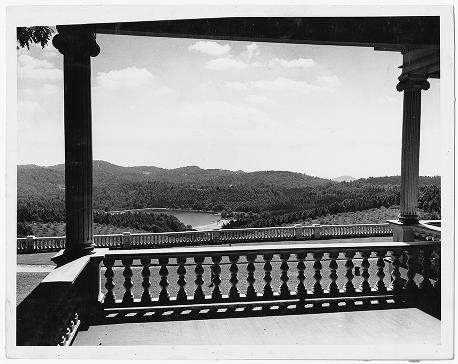If events had occurred differently in the 1960’s, the Blue Ridge Parkway’s Julian Price Memorial Park would currently by home to an “Americana Village.” Located at milepost 297, the Julian Price Memorial park was the proposed site for the re-creation of a stereotypical Appalachian community in the style of early America. The proposal for this village, initially located at Moses H. Cone Memorial Park,
was heavily influenced by the National Park Service’s Mission 66 and NPS’s partnership with the Southern Highland Handicraft Guild. Plans for the Americana Village went through many changes during the 1960’s before the project eventually fell through for reasons that are not clear.
The village was initially planned to be located at the Moses H. Cone Memorial Park, which was donated to the National Park Service in 1949 by the Moses H. Cone Memorial Hospital a few years following Bertha Cone’s death.[1] The home of Bertha and Moses Cone, Flat Top Manor, became a sales outlet and craft demonstration center for the Southern
Highland Handicraft Guild in the early 1950’s.[2]. Craft-making demonstrations were performed there and visitors could buy the guild’s products. When the National park Service (NPS) began its Mission 66 project, a ten-year project to improve visitor services by 1966 in time for the agency’s 50th anniversary, it was only logical to propose more visitor services at Moses H. Cone Memorial park because of its already successful operations.[3]
The director of the Guild, Robert Gray, hoped to have the Guild incorporated into plans for the Americana Village and corresponded for several years with the superintendent of the Blue Ridge Parkway, James Eden (1966-68), in an effort to accomplish this.[4] As it became clearer throughout the planning process that the Guild would not be guaranteed concessions at the Americana Village Robert Gray’s participation decreased.
The location and design of the village changed significantly from its first proposal to its final plan. The initial plan located the village at Moses. H. Cone Memorial Park. It would have consisted of a school house, farm, craft centers, a visitor center and parking. After a survey team examined the area proposed however, they produced the Interim Report Developed Area Narrative. It concluded that the topography and water sources located at Moses H. Cone were inadequate for the Americana Village.
To address the problems identified, the Interim Report proposed building most of the village at the neighboring Julian Price Memorial Park, which had flatter topography and streams for powering the proposed mills.[5] This change led to the development of the Master Plan for Americana at Julian Price Memorial Park which called for the entire village to moved to Julian Price Park. This plan was much more grandiose than the initial plan, with more than twice the amount of parking, more craft demonstrations, an amphitheater, a
training center for employees, and a fully functioning town.[6]
What did not change between the first plan and this final plan though were the stereotyped portrayals of Appalachian culture that the Blue Ridge Parkway and Southern Highland Craft Guild had long employed.
The relocation of the planned site for the Americana Village to Julian Price Memorial Park resulted in a new plan for the Moses H. Cone Memorial Park as well. It consisted of relocating the Southern Highland Craft Guild shop to Julian Price Park, restoring Flat Top Manor, and improving Cone Park’s trails and carriage lanes.[7] Just like plans for the Americana Village however, this final plan for Moses H. Cone Memorial Park was never completed.
The answer to why the Americana Village was never completed is not clear. Other NPS projects occurring at the same time may have received more attention because of the complexity and cost of constructing this village. Robert Gray’s reduced efforts to have the village constructed could have played a part. The ending of Mission 66 in 1966 along with budget cuts resulting from the Vietnam War may have been causes as well. Without any conclusive data there is only speculation.
[1] Phillip T. Noblitt, A Mansion in the Mountains the Story of Moses and Bertha Cone and Their Blowing Rock Manor (Boone, N.C.: Parkway Publishers, Inc., 1996).
[2] Ibid.
[3] Anne Mitchell Whisnant, Super-Scenic Motorway: A Blue Ridge Parkway History (Chapel Hill: UNC Press, 2006).
[4] Robert and James Eden, Correspondence, 1 June 1967- 26 December 1967, Blue Ridge Parkway Archives, Asheville, NC.
[5] R. N. McIntyre, “Master Plan Road to the Future of Blue Ridge Parkway: Development Analysis Julian Price Memorial Park,” October 25, 1967, Blue Ridge Parkway Archives, Asheville, NC.
[6] Arthur Beyer, et al, “Julian Price Memorial Park Developed Area Plan,” n.d., Blue Ridge Parkway Archives, Asheville, NC.
[7] Robert A. Hope, “Master Plan Road to the Future of Blue Ridge Parkway: Development Analysis Moses H. Cone Memorial Park Developed Area,” August, 1969, Blue Ridge Parkway Archives, Asheville, NC.

